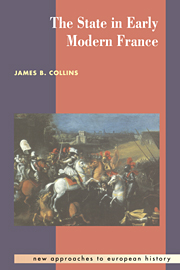Book contents
- Frontmatter
- Contents
- List of illustrations
- Preface
- Chronology of events
- Genealogy
- Glossary
- Historical background: the growth of the French state to 1627
- 1 The crucible, 1620s–1630s
- 2 The twenty years' crisis, 1635–1654
- 3 Louis XIV and the creation of the modern state
- 4 The debacle
- 5 A new France, 1720s–1750s
- 6 Reform, renewal, collapse
- 7 The crisis of 1787–1789
- Bibliography
- Index
- More Titles from the New Approaches to European History Series
2 - The twenty years' crisis, 1635–1654
Published online by Cambridge University Press: 05 June 2012
- Frontmatter
- Contents
- List of illustrations
- Preface
- Chronology of events
- Genealogy
- Glossary
- Historical background: the growth of the French state to 1627
- 1 The crucible, 1620s–1630s
- 2 The twenty years' crisis, 1635–1654
- 3 Louis XIV and the creation of the modern state
- 4 The debacle
- 5 A new France, 1720s–1750s
- 6 Reform, renewal, collapse
- 7 The crisis of 1787–1789
- Bibliography
- Index
- More Titles from the New Approaches to European History Series
Summary
War with Spain
From 1635 to 1659, France and Spain fought a war for political hegemony in western Europe. The effort required of the two states was such that it dismembered Spain, led to civil war in France, and induced governmental bankruptcies in both countries. Spain never recovered from the burdens it had to bear, slipping steadily in power after 1660. France emerged as the dominant power in Europe.
From our perspective, the outcome of this contest seems a foregone conclusion. France had a larger population and a much healthier demographic trend; France had a much more thoroughly integrated state than Spain; the French economy was varied and rich, that of Spain unbalanced and in decline. Contemporaries had rather a different view. Spain had the best army in Europe, the tercios, and the combination of Habsburg Spain and the revived Habsburg-ruled Holy Roman Empire seemed an overwhelming power. The Spanish could also draw upon the fabulous silver of Mexico and Peru to finance their armies. The king of Spain ruled the Franche-Comté, the duchy of Milan, and, through a vice-regent, the Spanish Netherlands as well. In short, he had France surrounded.
The war opened well for the French, with a victory at Avein (near Liege) and minor successes in the Rhine valley. Within weeks of its victory, however, the French army in Flanders melted away, unpaid and ravaged by disease. In early 1636, events began to confirm contemporary assessments of the two combatants: the Spanish army drove quickly into France, taking all of the fortifications in its path to Paris.
- Type
- Chapter
- Information
- The State in Early Modern France , pp. 61 - 78Publisher: Cambridge University PressPrint publication year: 1995

